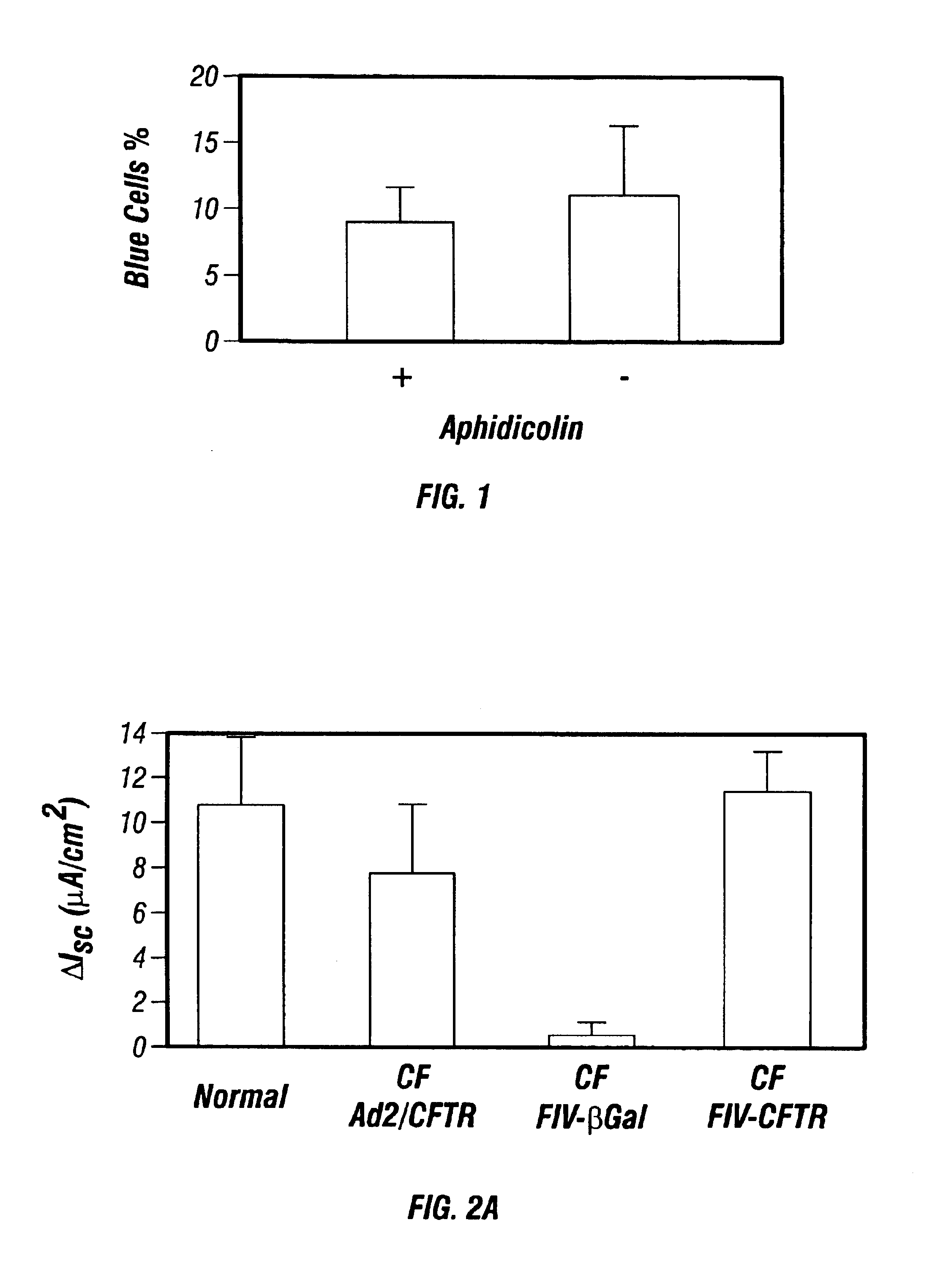Methods and compositions for increasing the infectivity of gene transfer vectors
a gene transfer and infectivity technology, applied in the field of virology, can solve the problems of limited efficacy of these vectors, low cellular viral infection rate, difficult in vivo transfer of foreign dnas into human cells, etc., and achieve the effects of increasing the transepithelial permeability, and increasing the susceptibility of epithelial cells
- Summary
- Abstract
- Description
- Claims
- Application Information
AI Technical Summary
Benefits of technology
Problems solved by technology
Method used
Image
Examples
example 1
[0189]Materials and Methods
[0190]The present example details some of the methods employed in the present invention.
[0191]I. Cell Culture Methods
[0192]Primary culture of human airway epithelia. Primary cultures of human airway epithelia were prepared from trachea and bronchi by enzymatic dispersion as previously described (Konda et al., 1991; Yamaya et al., 1992; Zabner et al., 1996). Briefly, epithelial cells were dissociated and seeded onto collagen-coated, semipermeable membranes with a 0.4 μm pore size (Millicell-HA, surface area 0.6 cm2, Millipore Corp., Bedford, Mass.). 24 hours after seeding, the mucosal media was removed and the cells were allowed to grow at the air-liquid interface as reported previously (Yamaya et al., 1992). The culture media consisted of a 1:1 mixture of DMEM and Ham's F12 with 2% Ultroser G (Sepracor Inc., Marlborough, Mass.), 100 U / ml Penicillin and 100 μg / ml Streptomycin. Representative preparations from all cultures were scanned by EM and the presence...
example 2
Growth Factors Stimulate Proliferation of Differentiated Airway Epithelia In Vitro and In Vivo
[0204]To determine whether growth factors are mitogenic to human airway epithelia, primary cultures of cells grown at the air-liquid interface were utilized. These cultures have ion transport properties and morphology similar to the intact surface epithelium (Smith et al., 1996; Kondo et al., 1991) and after 14 days in culture the cells are well-differentiated, ciliated, and have ion transport properties similar to the intact airways (Zabner et al., 1996; Yamaya et al., 1992). The data show that 200 ng / ml of HGF stimulated cell division 3-fold as measured by [3H] thymidine incorporation. After 24 hours of growth factor treatment, growth factor administration doubles the monolayer cell number compared to control. HGF treatment (200 ng / ml) increased cell labeling to 17-36%, while 5-10% of untreated controls were BrdU positive (n=3). EGF (200 ng / ml) and heregulin (5 nM) also both increased Brd...
example 3
An Integrating Vector can Target Nondividing Cells and Produce Persistent Expression and Correction of the CF Defect
[0212]If an integrating vector can infect nondividing cells it might offer advantages for gene transfer to airway epithelia because the level of proliferation in the airways in vivo is normally very low. Several recent studies demonstrate that hybrid lentiviral vectors infect nondividing mammalian cells (Naldini et al., 1996; Kafri et al., 1997). However, the one report of gene transfer to human airway epithelia with HIV-based lentivirus suggests that the gene transfer efficiency is greater in cells that are proliferating (Goldman et al., 1997). In a preliminary study, HIV-based lentivirus was applied to the apical or basal surface of differentiated human airway in basal media in the absence of growth factors. The vector expresses E coli β-galactosidase and the envelope is pseudotyped with the VSV-G protein. Crude vector supernatants were prepared by transiently co-tra...
PUM
| Property | Measurement | Unit |
|---|---|---|
| Permeability | aaaaa | aaaaa |
Abstract
Description
Claims
Application Information
 Login to View More
Login to View More - R&D
- Intellectual Property
- Life Sciences
- Materials
- Tech Scout
- Unparalleled Data Quality
- Higher Quality Content
- 60% Fewer Hallucinations
Browse by: Latest US Patents, China's latest patents, Technical Efficacy Thesaurus, Application Domain, Technology Topic, Popular Technical Reports.
© 2025 PatSnap. All rights reserved.Legal|Privacy policy|Modern Slavery Act Transparency Statement|Sitemap|About US| Contact US: help@patsnap.com



